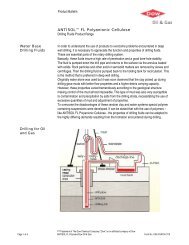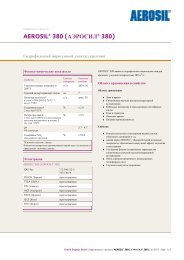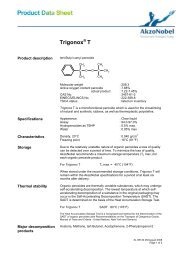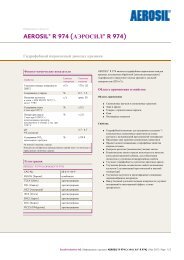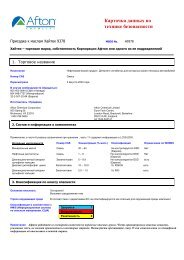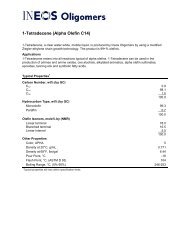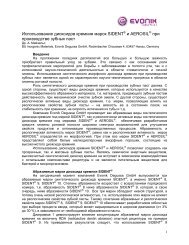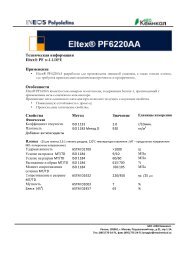VISIOMER®
VISIOMER®
VISIOMER®
Create successful ePaper yourself
Turn your PDF publications into a flip-book with our unique Google optimized e-Paper software.
<strong>VISIOMER®</strong><br />
Methacrylate monomers<br />
Sales range
The broadest range of products<br />
for a variety of applications<br />
2<br />
Versatile properties make<br />
methacrylate monomers the<br />
product of choice for a variety<br />
of applications. Hard or soft,<br />
hydrophobic or hydrophilic,<br />
<strong>VISIOMER®</strong> methacrylate<br />
monomers offer functionality<br />
and flexibility to solve specific<br />
application and performance<br />
challenges. Furthermore,<br />
Evonik Industries offers one<br />
of the broadest monomer<br />
product portfolios available.<br />
<strong>VISIOMER®</strong> methacrylate<br />
monomers can be found<br />
everywhere and when it comes<br />
to specialties – that’s where<br />
<strong>VISIOMER®</strong>`s innovative<br />
solutions really shine!<br />
Discover inspiring examples in<br />
paints and coatings, automotive,<br />
construction and adhesives<br />
applications just to name a few.<br />
© 2011, Evonik Industries AG<br />
<strong>VISIOMER®</strong> is a registered trademark of Evonik Röhm GmbH
Table of contents<br />
<strong>VISIOMER®</strong> – the brand for methacrylate monomers 4<br />
One source, one partner, a multitude of solutions 5<br />
Basic methacrylates 6<br />
Hydroxyesters 6<br />
Contact lens HEMA 7<br />
Alkyl/aryl (meth)acrylates 7<br />
Crosslinkers 8<br />
Ether methacrylates 9<br />
Aminofunctional monomers 10<br />
Methacrylamides 10<br />
Specialty methacrylates 11<br />
Intermediate products 11<br />
Regulatory information 12<br />
Applications 13<br />
Product application matrix 14<br />
3
4<br />
Automotive coatings<br />
Metal impregnation<br />
Concrete additives<br />
Reactive adhesives<br />
Architectural coatings<br />
In 1901, Dr. Otto Röhm, a pioneer in<br />
methacrylate polymer chemistry, began<br />
the long standing tradition of innovation<br />
within Evonik Industries.<br />
Industrial coatings<br />
Plastics<br />
Rubber modification<br />
Floor care products<br />
– the brand for methacrylate monomers<br />
Since then, Evonik and its predecessor companies<br />
have grown to become a preferred<br />
industry partner for innovative solutions<br />
in methacrylate monomers, some of the<br />
most versatile building blocks for polymer<br />
chemistry. Evonik`s methacrylate monomers<br />
are globally promoted under the<br />
trademark <strong>VISIOMER®</strong>.
Hair conditioner<br />
Cosmetics<br />
Contact lenses<br />
Leather coatings<br />
Paper sizing agents<br />
One source, one partner, a multitude of solutions<br />
From joint product development and<br />
specialized technical support to vendor<br />
managed inventory and warehousing,<br />
we develop solutions by means of strategic<br />
partnerships. From production to application,<br />
we provide know-how for an end to<br />
end solution.<br />
Through our international network of ISO<br />
9001 certified, strategically located, and<br />
integrated production facilities, we are<br />
able to develop tailored solutions based<br />
on the local needs of our customers while<br />
guaranteeing consistently high quality<br />
products.<br />
5
6<br />
Basic methacrylates<br />
<strong>VISIOMER®</strong> Chemical name Formula<br />
MMA<br />
GMAA<br />
n-BMA<br />
i-BMA<br />
Hydroxyesters<br />
<strong>VISIOMER®</strong> Chemical name Formula<br />
HEMA 97<br />
HEMA 98<br />
HPMA 97<br />
HPMA 98<br />
Molecular<br />
weight<br />
g/mol<br />
Molecular<br />
weight<br />
g/mol<br />
O<br />
OH<br />
O<br />
2-Hydroxyethyl<br />
methacrylate CAS-No. 868-77-9 130.1<br />
O<br />
OH<br />
O<br />
2-Hydroxyethyl<br />
methacrylate CAS-No. 868-77-9 130.1<br />
O (C₃H₆) OH<br />
Hydroxypropyl<br />
methacrylate CAS-No. 27813-02-1 144.2<br />
Hydroxypropyl<br />
O (C₃H₆) OH<br />
methacrylate CAS-No. 27813-02-1 144.2<br />
Boiling<br />
point<br />
°C/hPa<br />
Boiling<br />
point<br />
°C/hPa<br />
Glass<br />
transition<br />
temperature<br />
Tg °C<br />
O<br />
Methyl<br />
methacrylate CAS-No. 80-62-6 100.1 100/1013 105 100 ± 10<br />
Methacrylic<br />
OH<br />
acid CAS-No. 79-41-4 86.1 161/1013 185 200 ± 20<br />
O<br />
n-Butyl<br />
methacrylate CAS-No. 97-88-1 142.2 163/1013 20 100 ± 10<br />
i-Butyl<br />
O<br />
methacrylate CAS-No. 97-86-9 142.2 155/1013 53 100 ± 10<br />
*HQME = Hydroquinone monomethyl ether<br />
O<br />
O<br />
O<br />
O<br />
O<br />
O<br />
Glass<br />
transition<br />
temperature<br />
Tg °C<br />
213/1013 55 200 ± 20<br />
213/1013 55 200 ± 20<br />
209/1013 73 200 ± 20<br />
209/1013 73 200 ± 20<br />
Standard<br />
stabilization<br />
ppm<br />
HQME* Applications<br />
Standard<br />
stabilization<br />
ppm<br />
HQME Applications<br />
Hydroxyesters are recommended for heat or ambient cured, thermoset coatings with permanent marring and solvent resistance,<br />
high gloss retention and weatherability. Hydroxyfunctional prepolymers, for example, can be crosslinked via melamine resins,<br />
blocked isocyanates (one-component systems), or multifunctional isocyanates (two-component systems). Hydroxyesters also serve<br />
as adhesion promoters in reactive resins for bonding to metal surfaces.<br />
1.1<br />
3.2<br />
5.6<br />
1.1<br />
3.2<br />
5.2<br />
1.1<br />
5.1<br />
1.1<br />
5.1<br />
1.2<br />
5.2<br />
1.2<br />
5.2<br />
1.2<br />
5.2<br />
1.2<br />
5.2<br />
1.2<br />
3.3<br />
6.1<br />
1.2<br />
3.3<br />
1.2<br />
6.1<br />
1.2<br />
6.1<br />
2.2<br />
5.4<br />
2.2<br />
5.4<br />
2.2<br />
5.4<br />
2.2<br />
5.4<br />
2.1<br />
5.1<br />
7.1<br />
2.1<br />
3.5<br />
2.1<br />
7.2<br />
2.1<br />
3.3<br />
5.7<br />
3.3<br />
5.7<br />
3.3<br />
5.5<br />
3.3<br />
5.5<br />
2.2<br />
5.2<br />
7.2<br />
2.2<br />
5.1<br />
2.2<br />
2.2<br />
5.1<br />
5.1<br />
5.1<br />
5.7<br />
5.1<br />
5.7
Contact lens HEMA<br />
<strong>VISIOMER®</strong> Chemical name Formula<br />
UHP HEMA<br />
Alkyl/aryl (meth)acrylates<br />
<strong>VISIOMER®</strong> Chemical name Formula<br />
EHMA<br />
IDMA<br />
C13-MA<br />
C17.4-MA<br />
c-HMA<br />
IBOA<br />
IBOMA<br />
BNMA<br />
Molecular<br />
weight<br />
g/mol<br />
O<br />
Ultra high purity<br />
2-Hydroxyethyl<br />
O<br />
OH<br />
methacrylate CAS-No. 868-77-9 130.1<br />
O<br />
Molecular<br />
weight<br />
g/mol<br />
Boiling<br />
point<br />
°C/hPa<br />
Glass<br />
transition<br />
temperature<br />
Tg °C<br />
O<br />
2-Ethylhexyl<br />
methacrylate CAS-No. 688-84-6 198.3 218/1013 – 10 50 ± 10<br />
O<br />
Isodecyl<br />
O<br />
methacrylate CAS-No. 29964-84-9 226.0 > 250/1013 –70 100 ± 25<br />
O<br />
Methacrylic<br />
O [CH₂] CH<br />
n 3<br />
n≈12<br />
ester 13.0 CAS-No. 90551-76-1 268.0 > 300/1013 – 46 100 ± 25<br />
O<br />
Methacrylic<br />
O [CH₂] CH<br />
n 3<br />
n≈16,4<br />
ester 17.4 CAS-No. 90551-84-1 330.0 > 250/1013 – 22 100 ± 25<br />
O<br />
O<br />
Cyclohexyl<br />
methacrylate CAS-No. 101-43-9 168.2 210/1013 110 50 ± 5<br />
O<br />
O<br />
Isobornyl<br />
acrylate CAS-No. 5888-33-5 208.3 275/1013 96 250 ± 25<br />
O<br />
O<br />
Isobornyl<br />
methacrylate CAS-No. 7534-94-3 222.3 258/0.6 150 150 ± 30<br />
O<br />
Boiling<br />
point<br />
°C/hPa<br />
Glass<br />
transition<br />
temperature<br />
Tg °C<br />
213/1013 55 10 ± 3<br />
O<br />
Benzyl<br />
methacrylate CAS-No. 2495-37-6 176.0 243/1013 54 50 ± 5<br />
Standard<br />
stabilization<br />
ppm<br />
HQME Applications<br />
Standard<br />
stabilization<br />
ppm<br />
HQME Applications<br />
Alkyl methacrylate monomers are primarily used as building blocks for polymeric binders, generally known as synthetic resins.<br />
The excellent weather resistance of methacrylate polymers results from their purely aliphatic structure and effective steric hindrance<br />
of the polymer chains. There is hardly any oxidative degradation or ester hydrolysis in methacrylate polymers.<br />
A definitive example is acrylic glass, which is almost exclusively made of methyl methacrylate. With our range of monomers,<br />
polymer softening temperatures can be adjusted from approx. –70 °C to 150 °C. Long-chain esters, such as C17.4-MA, show waxlike<br />
polymer properties in their natural state. Esters with bulky side chains provide solution polymers with reduced viscosity and<br />
thus allowing higher solids content.<br />
6.3<br />
1.1<br />
3.4<br />
1.1<br />
5.1<br />
1.1<br />
1.1<br />
1.1<br />
1.1<br />
5.2<br />
1.1<br />
1.1<br />
1.2<br />
5.1<br />
1.2<br />
1.2<br />
1.2<br />
1.2<br />
1.2<br />
5.4<br />
1.2<br />
1.2<br />
2.2<br />
2.2<br />
3.2<br />
3.2<br />
5.1<br />
2.1<br />
5.1<br />
5.1<br />
3.2<br />
3.2<br />
5.1<br />
5.1<br />
5.1<br />
5.2<br />
7
8<br />
Crosslinkers<br />
<strong>VISIOMER®</strong> Chemical name Formula<br />
Molecular<br />
weight<br />
g/mol<br />
Boiling<br />
point<br />
°C/hPa<br />
Glass<br />
transition<br />
temperature<br />
Tg °C<br />
AMA Allyl methacrylate CAS-No. 96-05-9 126.2 141/1013 – 100 ± 20<br />
EGDMA<br />
TRGDMA<br />
PEG200DMA<br />
1,3-BDDMA<br />
1,4-BDDMA<br />
GDMA<br />
TMPTMA<br />
HEMATMDI<br />
¹⁾ BHT: 2,6-Di-tert-butyl-4-methylphenol<br />
O<br />
O<br />
Ethylene glycol<br />
O<br />
dimethacrylate CAS-No. 97-90-5 198.2 240/1013 – 100 ± 10<br />
O<br />
O<br />
O<br />
Triethylene glycol<br />
3<br />
O<br />
dimethacrylate CAS-No. 109-16-0<br />
O<br />
286.3 139/1 – 100 ± 20<br />
Polyethylene<br />
glycol 200<br />
dimethacrylate<br />
O<br />
CAS-No. 25852-47-5<br />
O<br />
n<br />
O<br />
n≈4<br />
336.0 > 200/0.13 – 200 ± 20<br />
O<br />
O<br />
1,3-Butanediol<br />
dimethacrylate CAS-No. 1189-08-8 226.3 110/4 – 200 ± 20<br />
O<br />
O<br />
O<br />
1,4-Butanediol<br />
O<br />
dimethacrylate CAS-No. 2082-81-7 226.3 > 200/1013 – 100 ± 10<br />
O<br />
O<br />
Glycerol<br />
OH<br />
dimethacrylate CAS-No. 1830-78-0 228.2 110/1013 – 200 ± 20<br />
Trimethylolpropane<br />
O<br />
trimethacrylate CAS-No. 3290-92-4 338.3 > 200 – 100 ± 10<br />
O<br />
O<br />
O<br />
O<br />
O<br />
O<br />
O<br />
O<br />
O<br />
O<br />
O<br />
NH NH<br />
C H<br />
O<br />
O<br />
O<br />
O O<br />
O<br />
O<br />
Diurethane<br />
O O<br />
dimethacrylate CAS-No. 72869-86-4 471.0 283/1013 – 225 ± 25¹⁾<br />
Standard<br />
stabilization<br />
ppm<br />
HQME Applications<br />
These products are characterized by a minimum of two polymerizable groups in one molecule. Polymerization leads to crosslinked<br />
and insoluble structures. Allyl methacrylate offers exceptional performance with two double bonds of different reactivity, allowing<br />
graft copolymerization in emulsions. Crosslinkers are ideally suited for hot and cold curing reactive adhesives and for peroxide<br />
crosslinking of high performance elastomers due to their low volatility and high reactivity.<br />
7.2<br />
3.4<br />
6.3<br />
3.4<br />
6.1<br />
3.4<br />
5.1<br />
5.6<br />
5.1<br />
5.6<br />
5.1<br />
5.1<br />
5.7<br />
5.4<br />
8.1<br />
5.1<br />
7.3<br />
5.1<br />
6.3<br />
5.1<br />
5.2<br />
5.7<br />
5.2<br />
5.7<br />
5.2<br />
5.2<br />
7.3<br />
6.1<br />
5.6<br />
5.2<br />
5.2<br />
5.3<br />
7.3<br />
5.3<br />
7.2<br />
5.3<br />
5.7<br />
5.3<br />
6.3<br />
5.5<br />
5.5<br />
7.3<br />
5.6
Ether methacrylates<br />
<strong>VISIOMER®</strong> Chemical name Formula<br />
ETMA<br />
THFMA<br />
BDGMA<br />
C18 PEG<br />
1105 MA W<br />
MPEG<br />
750 MA W<br />
MPEG<br />
2005 MA W<br />
MPEG<br />
5005 MA W<br />
Molecular<br />
weight<br />
g/mol<br />
Boiling<br />
point<br />
°C/hPa<br />
Glass<br />
transition<br />
temperature<br />
Tg °C<br />
Ethyltriglycol<br />
O<br />
O<br />
3<br />
methacrylate CAS-No. 39670-09-2<br />
O<br />
246.3 292/1013 – 31 100 ± 25<br />
Tetrahydrofurfuryl<br />
methacrylate<br />
CAS-No. 2455-24-5 170.2 222/1013 40<br />
Standard<br />
stabilization<br />
ppm<br />
HQME Applications<br />
100 ± 10<br />
+<br />
150 ± 15 ¹⁾<br />
O<br />
Butyl diglycol<br />
O<br />
O<br />
2<br />
methacrylate CAS-No. 7328-22-5 230.3 271/1013 60 100 ± 25<br />
Methacrylic ester<br />
(25 EO) C16-C18<br />
fatty alcohol<br />
O<br />
O<br />
O<br />
R<br />
n<br />
n=25 R=C₁₆– C₁₈<br />
(in water/GMAA) CAS-No. 70879-51-5 1432 200/1013 – 200 ± 20 2⁾<br />
O<br />
Methoxypolyethylene<br />
glycol 750<br />
O<br />
O<br />
n<br />
methacrylate<br />
n≈17<br />
(50 % in water) CAS-No. 26915-72-0 818 100/1013 – 200 ± 20<br />
Methoxypoly-<br />
O<br />
O<br />
n<br />
ethylene glycol<br />
2000 methacrylate<br />
n=45<br />
(50 % in water) CAS-No. 26915-72-0 2000 100/1013 – 200 ± 20<br />
Methoxypoly-<br />
O<br />
O<br />
n<br />
ethylene glycol<br />
5000 methacrylate<br />
n=113<br />
(50 % in water) CAS-No. 26915-72-0 5000 100/1013 – 200 ± 20<br />
¹⁾ BHT: 2,6-Di-tert-butyl-4-methylphenol 2⁾ 2,4-Dimethyl-6-tert-butylphenol<br />
O<br />
O<br />
O<br />
O<br />
O<br />
The favorable solution property of the ether functionality is combined with the high monomer reactivity of the methacrylate functionality.<br />
Unbranched ether methacrylates behave as internal plasticizers and provide polymers with very low glass transition temperatures.<br />
Due to their low volatility, these monomers can be used as reactive diluents for reactive systems. Long polyether side<br />
chains make the corresponding polymers water-soluble and capable of ion chelation.<br />
5.2<br />
5.1<br />
1.1<br />
2.1<br />
6.2<br />
2.1<br />
6.2<br />
3.2<br />
3.2<br />
5.4<br />
5.1<br />
3.2<br />
3.2<br />
3.4<br />
3.4<br />
5.4<br />
3.4<br />
3.4<br />
3.5<br />
3.5<br />
3.5<br />
3.5<br />
6.2<br />
6.2<br />
9
Aminofunctional monomers<br />
<strong>VISIOMER®</strong> Chemical name Formula<br />
MADAME<br />
DMAPMA<br />
TMAEMC<br />
MAPTAC<br />
Methacrylamides<br />
<strong>VISIOMER®</strong> Chemical name Formula<br />
10<br />
Molecular<br />
weight<br />
g/mol<br />
Boiling<br />
point<br />
°C/hPa<br />
Glass<br />
transition<br />
temperature<br />
Tg °C<br />
MAAmide Methacrylamide CAS-No. 79-39-0 85.1 215/1013 250 –<br />
N-MMAA<br />
O<br />
Molecular<br />
weight<br />
g/mol<br />
Boiling<br />
point<br />
°C/hPa<br />
Glass<br />
transition<br />
temperature<br />
Tg °C<br />
2-Dimethyl aminoethyl<br />
methacrylate CAS-No. 2867-47-2 157.2 182/1013 18 800 ± 80<br />
O<br />
NH N<br />
3-Dimethyl aminopropyl<br />
methacrylamide CAS-No. 5205-93-6 170.0 263/1013 96 675 ± 75<br />
O<br />
+<br />
O<br />
N CI –<br />
2-Trimethylammoniumethyl<br />
methacrylate chloride<br />
(aqueous solution) CAS-No. 5039-78-1 207.7 100/1013 – 600 ± 60<br />
O<br />
O<br />
N<br />
+<br />
CI –<br />
3-Trimethylammoniumpropyl<br />
methacrylamide chloride<br />
(aqueous solution) CAS-No. 51410-72-1 220.5 100/1013 – 200 ± 20<br />
NH OH<br />
N-Methylol methacrylamide<br />
(aqueous solution) CAS-No. 923-02-4 115.1 100/1013 59 120 ± 20<br />
Standard<br />
stabilization<br />
ppm<br />
HQME Applications<br />
Standard<br />
stabilization<br />
ppm<br />
HQME Applications<br />
Combinations of methacrylamide and acetal-modified methacrylamides are recommended for heat activated self-crosslinking<br />
resins. Methacrylamide alone can be used as a polar co-monomer with high Tg, for improving solvent resistance and cohesion.<br />
In a special application, methacrylamide can be grafted onto natural fibers (silk weighting).<br />
1.1<br />
4.3<br />
1.1<br />
4.3<br />
2.1<br />
7.1<br />
3.3<br />
3.2<br />
5.2<br />
3.2<br />
5.2<br />
3.1<br />
4.1<br />
6.2<br />
4.1<br />
6.2<br />
3.3<br />
4.2<br />
4.2<br />
3.5 4.1 4.2 4.3<br />
6.2<br />
3.5 4.1 4.2 4.3<br />
Predominantly used in their quaternized form, these products provide water-soluble cationic polymers with ionic groups.<br />
Combining these products with either hydrophilic or hydrophobic co-monomers results in a wide variation of the physical properties<br />
of these polymers. Copolymers containing these monomers are excellent flocculation agents and can furthermore be used as<br />
cationic thickeners.<br />
O<br />
NH<br />
O<br />
NH₂<br />
N<br />
6.2<br />
6.2
Specialty methacrylates<br />
<strong>VISIOMER®</strong> Chemical name Formula<br />
MEEU 50 W<br />
MEEU 25 M<br />
¹⁾ Phenothiazine<br />
Molecular<br />
weight<br />
g/mol<br />
Boiling<br />
point<br />
°C/hPa<br />
O<br />
N NH<br />
O<br />
O<br />
N-(2-Methacryloyloxyethyl)<br />
ethylene urea (50 % in Water) CAS-No. 86261-90-7 198.2 100/1013 –<br />
O<br />
N NH<br />
O<br />
N-(2-Methacryloyloxyethyl)<br />
ethylene urea (25 % in methyl<br />
O<br />
methacrylate) CAS-No. 86261-90-7 198.2 100/1013 –<br />
Glass<br />
transition<br />
temperature<br />
Tg °C<br />
Standard<br />
stabilization<br />
ppm<br />
HQME Applications<br />
800 ± 100<br />
+<br />
150 ± 50 ¹⁾<br />
500 ± 100<br />
+<br />
max. 100 ¹⁾<br />
The advantage of the MEEU ureidofunctional monomer can be found in emulsion polymers which are able to obtain desired wet<br />
adhesion properties. It improves the adhesion properties of the emulsion polymers especially on wood or aged alkyd paint surfaces<br />
as well as the wet scrub resistance of the final products.<br />
Intermediate products<br />
<strong>VISIOMER®</strong> Chemical name Formula<br />
Molecular<br />
weight<br />
g/mol<br />
Boiling<br />
point<br />
°C/hPa<br />
Glass<br />
transition<br />
temperature<br />
Tg °C<br />
ECH Ethylene cyanohydrin CAS-No. 109-78-4 71 221/1013 – –<br />
2.1<br />
2.1<br />
Standard<br />
stabilization<br />
ppm<br />
HQME Applications<br />
2) ACH Acetone cyanohydrin CAS-No. 75-86-5 85.1 120/1013 ¹⁾ – 3000<br />
8.1<br />
¹⁾ decomposition 2⁾ Sulfuric Acid<br />
HO<br />
HO CN<br />
CN<br />
Based on our highly flexible production processes for this wide variety of monomers, we have developed expertise in a number of<br />
key technologies, allowing us to offer several intermediate products suitable for organic synthesis.<br />
Evonik is a highly experienced partner in the development of specific products based on methacrylate chemistry. New monomers<br />
have been developed resulting in specific property enhancements as well as special grades of existing products, all tailored to the<br />
special needs of our customers.<br />
8.1<br />
11
Regulatory information<br />
It is our aim to have all of our products registered and made available<br />
to customers, wherever there is a need, worldwide.<br />
All <strong>VISIOMER®</strong> products conform to the REACH regulations<br />
(REACH = Registration, Evaluation, Authorisation and Restriction of Chemicals)<br />
and have been either registered or pre-registered under REACH to ensure<br />
continuous supply availability.<br />
Please refer to the materials safety data sheet for current status of<br />
registration, or contact customer service at: +49 6151 18-1002<br />
12
Applications<br />
1. Solvent borne coating Page<br />
1.1 Paint resins 6, 7, 9, 10<br />
1.2 Reactive coatings (OEM, industrial) 6, 7<br />
2. Emulsion polymers<br />
2.1 Water borne coatings 6, 7, 9, 10, 11<br />
2.2 Floor care products 6, 7<br />
3. Performance products<br />
3.1 Silk grafting 10<br />
3.2 Oil and gas applications 6, 7, 9, 10<br />
3.3 Textile coating / fiber bonding 6, 10<br />
3.4 Absorbing materials 7, 8, 9<br />
3.5 Emulsifiers, dispersants & thickeners 6, 9, 10<br />
4. Paper and water<br />
4.1 Flocculants 10<br />
4.2 Retention and dewatering aids 10<br />
4.3 Sizing additives 10<br />
5. Reactive systems<br />
5.1 Reactive adhesives & sealants 6, 7, 8, 9<br />
5.2 Photopolymer plates and photoresists 6, 7, 8, 9,10<br />
5.3 Additives for PVC plastisols 8<br />
5.4 Radiation curing 6, 7, 8, 9<br />
5.5 Reactive thinners<br />
for unsaturated polyester resins<br />
6, 8<br />
5.6 Artificial marble / solid surface 6, 8<br />
5.7 Chemical fixing 6, 8<br />
6. Health and cosmetics Page<br />
6.1 Dental compounds 6, 8<br />
6.2 Cosmetics 9, 10<br />
6.3 Contact lenses 7, 8<br />
7. Plastics and elastomers<br />
7.1 Acrylic sheet 6, 10<br />
7.2 Modifiers and processing aids 6, 8<br />
7.3 Rubber additives 8<br />
8. Intermediates for synthesis<br />
8.1 Building blocks 8, 11<br />
13
Product application matrix<br />
Basic methacrylates<br />
Hydroxyesters<br />
Alkyl/aryl (meth)acrylates<br />
Aminofunctional monomers<br />
Methacrylamides<br />
Crosslinkers<br />
Ether methacrylates<br />
Specialty methacrylates<br />
Intermediate products<br />
14<br />
Products<br />
Methyl methacrylate<br />
Methacrylic acid<br />
n-Butyl methacrylate<br />
i-Butyl methacrylate<br />
2-Hydroxyethyl methacrylate 97 % / 98 %<br />
2-Hydroxypropyl methacrylate 97 % / 98 %<br />
2-Hydroxyethyl methacrylate UHP<br />
2-Ethylhexyl methacrylate<br />
Isodecyl methacrylate<br />
Methacrylic ester 13.0<br />
Methacrylic ester 17.4<br />
Cyclohexyl methacrylate<br />
Isobornyl acrylate<br />
Isobornyl methacrylate<br />
Benzyl methacrylate<br />
2-Dimethylaminomethyl methacrylate<br />
3-Dimethylaminopropyl methacrylamide<br />
2-Trimethylammoniumethyl methacrylate chloride<br />
3-Trimethylammoniumpropyl methacrylamide chloride<br />
Methacrylamide<br />
N-Methylol methacrylamide<br />
Allyl methacrylate<br />
Ethylene glycol dimethacrylate<br />
Triethylene glycol dimethacrylate<br />
Polyethylene glycol 200 dimethacrylate<br />
1,3-Butanediol dimethacrylate<br />
1,4-Butanediol dimethacrylate<br />
Glycerol dimethacrylate<br />
Trimethylolpropane trimethacrylate<br />
Diurethane dimethacrylate<br />
Ethyltriglycol methacrylate<br />
Tetrahydrofurfuryl methacrylate<br />
Butyl diglycol methacrylate<br />
Metharylic ester of an ethoxylated fatty alcohol<br />
Methoxypolyethylene glycol 750 methacrylate<br />
Methoxypolyethylene glycol 2000 methacrylate<br />
Methoxypolyethylene glycol 5000 methacrylate<br />
N-(2-Methacryloyloxyethyl) ethylene urea 25 % in MMA or 50 % in water<br />
Ethylene cyanohydrine<br />
Acetone cyanohydrine
1. Solvent borne coating<br />
1.1 Paint resins<br />
▯ ▯ ▯ ▯ ▯ ▯ ▯ ▯ ▯ ▯ ▯ ▯ ▯ ▯ ▯<br />
1.2 Reactive coatings<br />
(OEM, industrial)<br />
▯ ▯ ▯ ▯ ▯ ▯ ▯ ▯ ▯ ▯ ▯ ▯ ▯ ▯<br />
2. Emulsion polymers<br />
2.1 Water borne coatings<br />
▯ ▯ ▯ ▯ ▯ ▯ ▯ ▯ ▯<br />
2.2 Floor care products<br />
▯ ▯ ▯ ▯ ▯ ▯ ▯ ▯<br />
3. Performance products<br />
3.1 Silk grafting<br />
▯<br />
3.2 Oil and gas applications<br />
▯ ▯ ▯ ▯ ▯ ▯ ▯ ▯ ▯ ▯ ▯ ▯<br />
3.3 Textile coating / fiber bonding<br />
▯ ▯ ▯ ▯ ▯ ▯<br />
3.4 Absorbing materials<br />
▯ ▯ ▯ ▯ ▯ ▯ ▯ ▯<br />
3.5 Emulsifiers, dispersants<br />
& thickeners<br />
▯ ▯ ▯ ▯ ▯ ▯ ▯<br />
4. Paper and water<br />
4.1 Flocculants<br />
▯ ▯ ▯ ▯<br />
4.2 Retention and dewatering aids<br />
▯ ▯ ▯ ▯<br />
4.3 Sizing additives<br />
▯ ▯ ▯ ▯<br />
5. Reactive systems<br />
5.1 Reactive adhesives and sealants<br />
▯ ▯ ▯ ▯ ▯ ▯ ▯ ▯ ▯ ▯ ▯ ▯ ▯ ▯ ▯ ▯ ▯ ▯ ▯ ▯ ▯ ▯ ▯<br />
5.2 Photopolymer plates<br />
and photoresists<br />
▯ ▯ ▯ ▯ ▯ ▯ ▯ ▯ ▯ ▯ ▯ ▯ ▯ ▯ ▯<br />
5.3 Additives for PVC plastisols<br />
▯ ▯ ▯ ▯<br />
5.4 Radiation curing<br />
▯ ▯ ▯ ▯ ▯ ▯<br />
5.5 Reactive thinners for<br />
unsaturated polyester resins<br />
▯ ▯ ▯<br />
5.6 Artificial marble / solid surface<br />
▯ ▯ ▯ ▯ ▯<br />
5.7 Chemical fixing<br />
▯ ▯ ▯ ▯ ▯ ▯<br />
6. Health and cosmetics<br />
6.1 Dental compounds<br />
▯ ▯ ▯ ▯ ▯<br />
6.2 Cosmetics<br />
▯ ▯ ▯ ▯ ▯ ▯ ▯ ▯ ▯<br />
6.3 Contact lenses<br />
▯ ▯ ▯ ▯<br />
7. Plastics & elastomers<br />
7.1 Acrylic sheet<br />
▯ ▯<br />
7.2 Modifiers and processing aids<br />
▯ ▯ ▯ ▯<br />
7.3 Rubber additives<br />
▯ ▯ ▯ ▯<br />
8. Intermediates for synthesis<br />
8.1 Building blocks<br />
▯ ▯ ▯<br />
15
NAFTA<br />
Evonik Cyro LLC<br />
299 Jefferson Road<br />
P.O. Box 677<br />
Parsippany, NJ 07054-0677<br />
USA<br />
toll free +1 800 225-0172<br />
Evonik Industries AG<br />
Kirschenallee<br />
64293 Darmstadt<br />
Germany<br />
phone +49 6151 18-1002<br />
fax +49 6151 18-3155<br />
visiomer@evonik.com<br />
www.visiomer.com<br />
www.evonik.com<br />
Asia Pacific<br />
Evonik Degussa (China) Co. Ltd.<br />
55 Chundong Road,<br />
Xinzhuang Industrial Park,<br />
Shanghai 201108<br />
P. R. China<br />
phone +86 21 6119-1349<br />
fax +86 21 6119-1116<br />
® = registered trademark<br />
This information and all further technical<br />
advice is based on our present knowledge<br />
and experience. However, it implies no<br />
liability or other legal responsibility on<br />
our part, including with regard to existing<br />
third party intellectual property rights,<br />
especially patent rights. In particular,<br />
no warranty, whether express or implied,<br />
or guarantee of product properties in the<br />
legal sense is intended or implied.<br />
We reserve the right to make any changes<br />
according to technological progress or<br />
further developments. The customer is not<br />
released from the obligation to conduct<br />
careful inspection and testing of incoming<br />
goods. Performance of the product described<br />
herein should be verified by testing, which<br />
should be carried out only by qualified<br />
experts in the sole responsibility of a<br />
customer. Reference to trade names used<br />
by other companies is neither a<br />
recommendation, nor does it imply that<br />
similar products could not be used.<br />
xx/1011/08440 (en)



